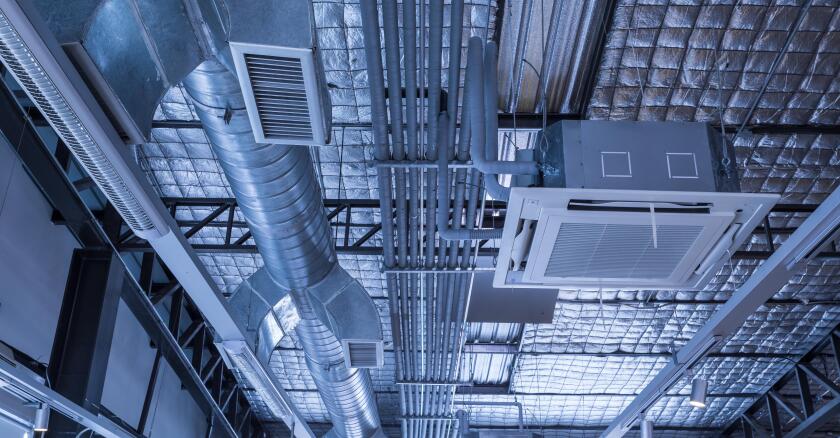Heating, ventilation and air conditioning, or HVAC, systems are nothing new. When they're working right, they are practically unnoticeable.
When the federal government distributed millions of pandemic relief dollars to public schools, HVAC system upgrades were one of the many approved uses of the money. Since then, Yakima County school districts have budgeted for millions of dollars in federal money to upgrade their HVAC systems. Others have recently spent money from their regular budgets for HVAC upgrades.
Properly working HVAC systems help circulate fresh air throughout a building, making them a long-term COVID strategy as schools consider how to move forward with the virus still out there.
HVAC 101
HVAC systems are the heating and cooling systems for buildings. The systems bring in outside air and help circulate air throughout the building and make sure it's at the desired temperature. These systems also have filters that can catch impurities in the air, like wildfire smoke, said Union Gap School District Director of Operations and Technology Tony Silver.
Maintenance staff strive for energy efficient HVAC systems, Silver said.
The systems at schools are like the ones people have at their homes, just on a larger scale, said Selah School District Facilities Director Frank Reno.
In modern school buildings, these systems are controlled via computers. From his screen Silver can see all sorts of data related to the HVAC system, like what temperature the outside air is entering the system at and the building pressure. Maintenance workers must make sure that what is on the screen matches what's actually happening in the system, a testing process Union Gap underwent recently.
Like other mechanical devices, the systems require maintenance. Smaller filters may have to be changes out yearly, Reno said. Filters on larger, outdoor units may last longer, but still need to be replaced regularly.
"If you do that, it really prolongs the life of the equipment and promotes a much healthier environment for staff and students to work," Reno said.
INVESTMENTS IN HVAC
Several school districts in Yakima County have either recently completed or are planning significant HVAC upgrades. Much of the budget for those projects has come from federal Elementary and Secondary School Emergency Relief funds, which came in three waves. Schools can use ESSER funds until fall 2024.
In the Yakima School District, about $1.2 million worth of federal funds were used to purchase medical-grade, high efficiency particle air filters. A districtwide project earlier this year put these filters in highly trafficked areas, like classrooms, said YSD Communications Director Kirsten Fitterer.
HEPA filters use extremely fine mesh to keep small particles out of the air. Early anecdotal reports indicated that the smell of smoke was nearly undetectable inside during wildfire season this year, Fitterer said.
The district will partner with the University of Washington for a project that will test indoor air quality in schools, Fitterer said.
In Sunnyside, the county's second largest district, school officials purchased air purifiers and advanced filters for its eight schools. It is also planning a $4 million project to upgrade the HVAC system at Chief Kamiakin Elementary and a $2.5 million project to upgrade the system at Harrison Middle School, District Communications director Jessica Morgan said in an email.
Selah School District has almost wrapped up its districtwide HVAC project. Using federal funds, the district conducted a review of the HVAC systems at its campuses and made the appropriate upgrades. The most extensive work was done at the intermediate school, Reno said.
That project cost $364,000, paid for by ESSER funds, Selah's Associate Superintendent for District Operations Chris Scacco said in an email.
East Valley, Mabton, Toppenish, Granger and Union Gap school districts also have made significant investments into HVAC upgrades and maintenance.
IMPORTANCE OF HVAC
Good air circulation can help limit the spread of COVID-19, a virus that spreads through respiratory droplets in the air. Other strategies to reduce transmission, like masks and social distancing, were made optional earlier this year.
Fitterer said that after the start of the pandemic, YSD prioritized clean air and better circulation in its buildings.
"It's important because so many people spend time in school during the day that we are proud of the investment that we have made to make sure that the air is clean for them," said Fitterer.
The pandemic is not the only reason schools have been focused on HVAC in recent years. The ongoing concern of wildfires plus a 2019 bill that updated indoor air quality and energy efficiency standards also pushed the issue forward, Reno said.
Even in non-pandemic times, airborne illnesses can cause students and staff to miss class. Properly maintaining HVAC units can help combat learning losses by improving the school environment, Silver said.
Local districts have decided that sort of protection is worth the price.
©2022 Yakima Herald-Republic (Yakima, Wash.). Distributed by Tribune Content Agency, LLC.















